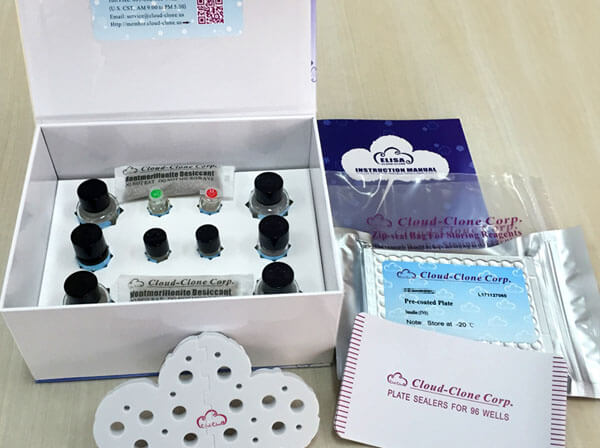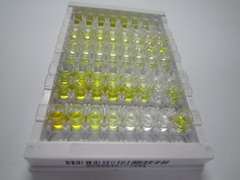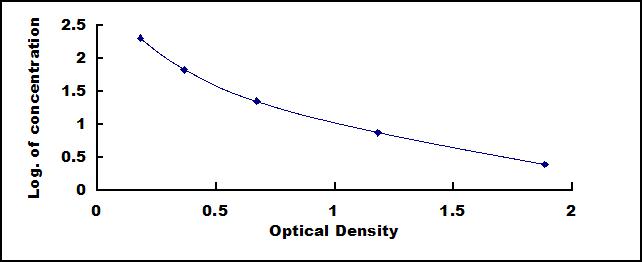ELISA Kit for Salusin Alpha (SALa) 

- UOM
- FOB US$ 466.00 US$ 665.00 US$ 2,993.00 US$ 5,653.00 US$ 46,550.00
- Quantity
Overview
Properties
- Product No.CEB892Hu
- Organism SpeciesHomo sapiens (Human) Same name, Different species.
- ApplicationsEnzyme-linked immunosorbent assay for Antigen Detection.
Research use only - DownloadInstruction Manual
- CategoryInfection immunityEndocrinologyCardiovascular biologyNeuro science
Sign into your account
Share a new citation as an author
Upload your experimental result
Review

Contact us
Please fill in the blank.
Recovery
Matrices listed below were spiked with certain level of recombinant Salusin Alpha (SALa) and the recovery rates were calculated by comparing the measured value to the expected amount of Salusin Alpha (SALa) in samples.
| Matrix | Recovery range (%) | Average(%) |
| serum(n=5) | 89-98 | 92 |
| EDTA plasma(n=5) | 94-102 | 98 |
| heparin plasma(n=5) | 78-98 | 89 |
Precision
Intra-assay Precision (Precision within an assay): 3 samples with low, middle and high level Salusin Alpha (SALa) were tested 20 times on one plate, respectively.
Inter-assay Precision (Precision between assays): 3 samples with low, middle and high level Salusin Alpha (SALa) were tested on 3 different plates, 8 replicates in each plate.
CV(%) = SD/meanX100
Intra-Assay: CV<10%
Inter-Assay: CV<12%
Linearity
The linearity of the kit was assayed by testing samples spiked with appropriate concentration of Salusin Alpha (SALa) and their serial dilutions. The results were demonstrated by the percentage of calculated concentration to the expected.
| Sample | 1:2 | 1:4 | 1:8 | 1:16 |
| serum(n=5) | 85-96% | 91-101% | 83-91% | 91-98% |
| EDTA plasma(n=5) | 81-102% | 94-102% | 87-103% | 84-91% |
| heparin plasma(n=5) | 97-104% | 88-95% | 92-101% | 78-105% |
Stability
The stability of kit is determined by the loss rate of activity. The loss rate of this kit is less than 5% within the expiration date under appropriate storage condition.
To minimize extra influence on the performance, operation procedures and lab conditions, especially room temperature, air humidity, incubator temperature should be strictly controlled. It is also strongly suggested that the whole assay is performed by the same operator from the beginning to the end.
Reagents and materials provided
| Reagents | Quantity | Reagents | Quantity |
| Pre-coated, ready to use 96-well strip plate | 1 | Plate sealer for 96 wells | 4 |
| Standard | 2 | Standard Diluent | 1×20mL |
| Detection Reagent A | 1×120µL | Assay Diluent A | 1×12mL |
| Detection Reagent B | 1×120µL | Assay Diluent B | 1×12mL |
| TMB Substrate | 1×9mL | Stop Solution | 1×6mL |
| Wash Buffer (30 × concentrate) | 1×20mL | Instruction manual | 1 |
Assay procedure summary
1. Prepare all reagents, samples and standards;
2. Add 50µL standard or sample to each well.
And then add 50µL prepared Detection Reagent A immediately.
Shake and mix. Incubate 1 hour at 37°C;
3. Aspirate and wash 3 times;
4. Add 100µL prepared Detection Reagent B. Incubate 30 minutes at 37°C;
5. Aspirate and wash 5 times;
6. Add 90µL Substrate Solution. Incubate 10-20 minutes at 37°C;
7. Add 50µL Stop Solution. Read at 450 nm immediately.

Test principle
This assay employs the competitive inhibition enzyme immunoassay technique. A monoclonal antibody specific to Salusin Alpha (SALa) has been pre-coated onto a microplate. A competitive inhibition reaction is launched between biotin labeled Salusin Alpha (SALa) and unlabeled Salusin Alpha (SALa) (Standards or samples) with the pre-coated antibody specific to Salusin Alpha (SALa). After incubation the unbound conjugate is washed off. Next, avidin conjugated to Horseradish Peroxidase (HRP) is added to each microplate well and incubated. The amount of bound HRP conjugate is reverse proportional to the concentration of Salusin Alpha (SALa) in the sample. After addition of the substrate solution, the intensity of color developed is reverse proportional to the concentration of Salusin Alpha (SALa) in the sample.
Giveaways
Increment services
Citations
- The bioactive peptides salusins and apelin–36 are produced in human arterial and venous tissues and the changes of their levels during cardiopulmonary bypassPubMed: 22884920
- Presence of adropin, nesfatin-1, apelin-12, ghrelins and salusins peptides in the milk, cheese whey and plasma of dairy cowsScienceDirect: S0196978113000533
- Association of low maternal levels of salusins with gestational diabetes mellitus and with small-for-gestational-age fetuses.PubMed: 23178004
- Salusin-alpha and -beta expression in heart and aorta with and without metabolic syndromePubmed: 23957705
- Concentrations of preptin, salusins and hepcidins in plasma and milk of lactating women with or without gestational diabetes mellitusScienceDirect: S0196978113003100
- Brain, Liver, and Serum Salusin-alpha and-beta Alterations in Sprague-Dawley Rats with or Without Metabolic SyndromePubmed:Pmc4136931
- Is the serum level of salusin-β associated with hypertension and atherosclerosis in the pediatric population?Pubmed:25245503
- Serum salusin-α and salusin-β levels in patients with psoriasisPubMed: 26055619
- Serum salusins levels are increased and correlated positively with cyst size in ovarian endometriomaPubMed: 26008602
- Increased level of Plasma Salusin-α and Salusin-β in patients with Multiple SclerosisPubmed: 30738876
- Salusin-α levels are negatively correlated with diastolic blood pressure in children with obesityPubmed: 31486354
- Salusin-α mitigates diabetic nephropathy via inhibition of the Akt/mTORC1/p70S6K signaling pathway in diabetic ratsPubmed: 31665937
- Salusin-β is superior to salusin-α as a marker for evaluating coronary atherosclerosisPubmed: 32054363
- Targeted Delivery of Salusin©\¦Á into Rabbit Carotid Arterial Endothelium Using SonoVue33818784
- Inhibition of oxidative stress and apoptosis by camel milk mitigates cyclosporine©\induced nephrotoxicity: Targeting Nrf2/HO©\1 and AKT/eNOS/NO pathways34136182











